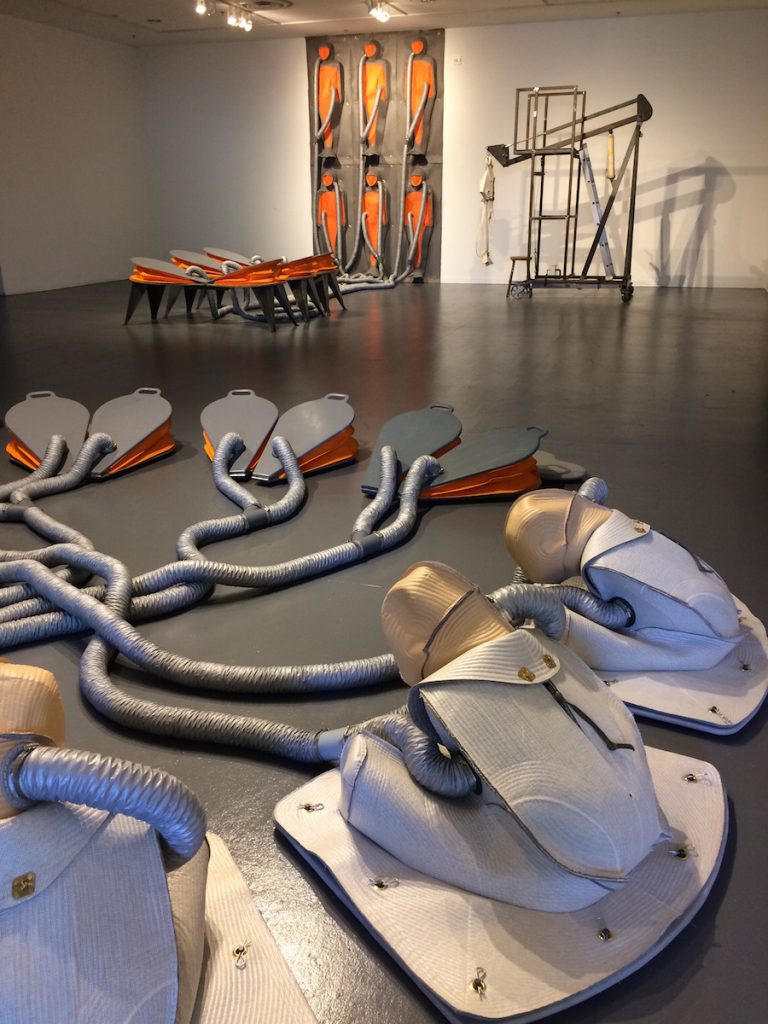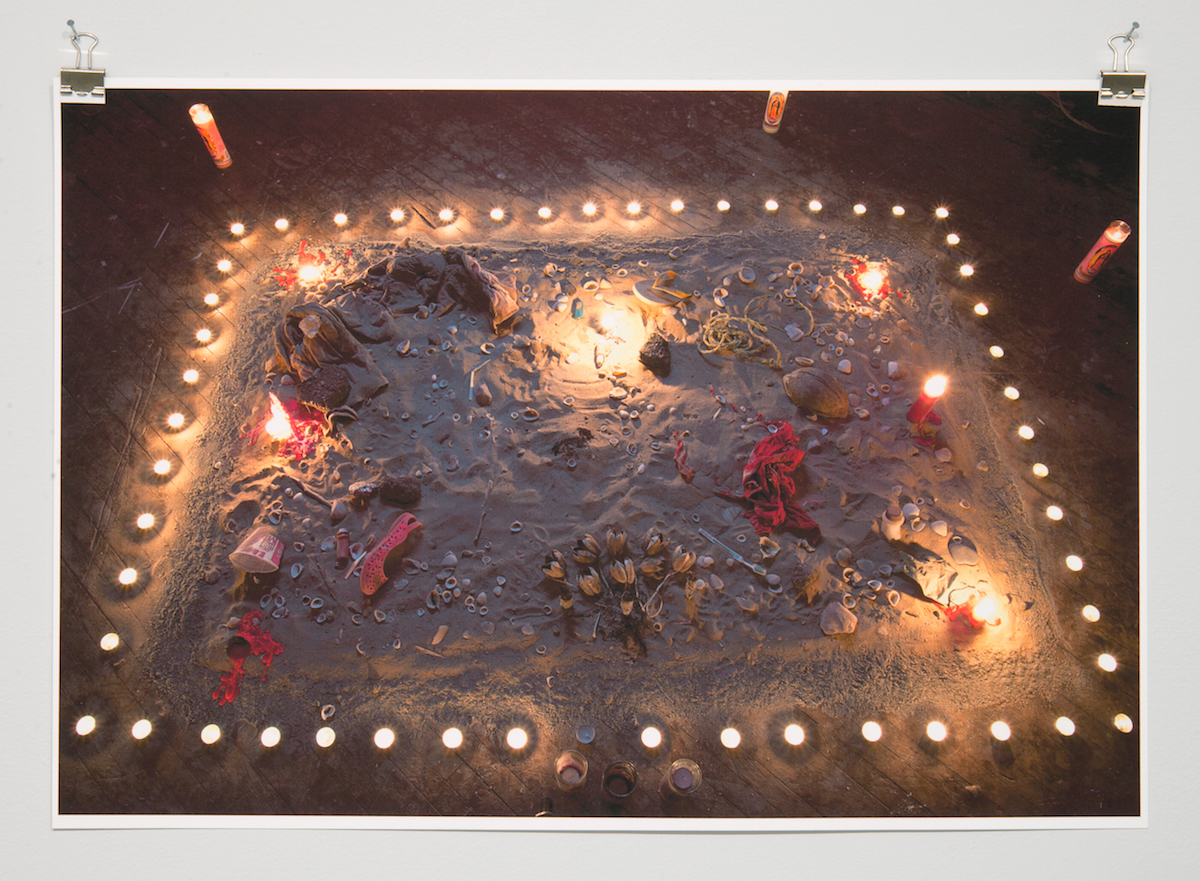This week has me thinking a lot about the breath. Breathing—an unconscious act until it suddenly becomes difficult.
Watching the election results come in Tuesday night, a dozen versions of the same GIF showed up in my Facebook feed. A dot becoming a line growing into the outline of a triangle, then square, up to an octagon before collapsing in upon itself again in an endless loop. Breathe in. Breathe out.

I thought about my breath when I woke up Wednesday morning with a tightness in my chest that wouldn’t subside. As I lay in bed that night, sleepless—pain in my left arm worrying me that I was having a heart attack and not just that I’d used my left hand to scroll far too much that day—I finally turned to my meditation app. I counted to ten, a breath for every number.
At the Creative Alliance, David Page’s Security Theater presents an opportunity to consider breath and breathing as a collective act, blurring the lines between participation, bondage, and submission in two large-scale sculptural and performance objects.

 “Pulmonate” sits in a circular arrangement on the floor as you enter the gallery. The piece is composed of five human-shaped suits sitting on the floor in a cross-legged position, their arms presumably behind their back. These suits are made from light colored packing blankets, finely crafted to cover the entire body and head—akin to antique scuba gear or gasmasks—stitched in decorative lines and concentric circles. They are intended for human beings to inhabit and wear, submitting to their bondage and becoming intentionally, collectively vulnerable in a connected system for breathing.
“Pulmonate” sits in a circular arrangement on the floor as you enter the gallery. The piece is composed of five human-shaped suits sitting on the floor in a cross-legged position, their arms presumably behind their back. These suits are made from light colored packing blankets, finely crafted to cover the entire body and head—akin to antique scuba gear or gasmasks—stitched in decorative lines and concentric circles. They are intended for human beings to inhabit and wear, submitting to their bondage and becoming intentionally, collectively vulnerable in a connected system for breathing.
The figures sit atop small platforms, the protective fabric grommeted along the edges and secured to the platform by retaining clips that are sometimes used to secure padding to the walls of an elevator. Ducts escape from the back of the neck and the left side of the chest, converging in a mixture that spreads across the circle to connect to five pairs of bellows for volunteers to pump, providing air to those inside.
Each bellow has a handle on its edge and a small rump-shaped cushion placed in front of the pair, both evoking the shape of a heart. The bellows are an industrial gray but their inner lining glows bright orange. The cushions and handles are an invitation to participate, to literally push air through the ducts into the suits. You must pump the bellows to give breath to those confined inside the suits, creating a sensation of fear and urgency.

Against the back wall, “Stack” offers a similar arrangement of bellows attached to human-shaped fabric figures. This group, though, is upright and attached to the wall, one row of three stacked below another. The face and body flatly glare at us in bright orange while the sides of the body, a background of fabric clipped to the wall and the ducts are an industrial gray. Nearby stands a metal-framed device on wheels with a ladder leading up to a platform and a restraining bodice hanging from a retractable arm below which sits a wooden stool. This structure is infused with a mad scientist feeling that calls to mind acts of torture and neglect; it is highly creepy and unsettling.
During live performances on November 12, I watched Page and a small team of assistants bind and blindfold performers before helping them into the proper positions of submission beneath the fabric suits. His choice of packing blankets—a material to pad and insulate, a form of protection during relocation—to cover a captive body whose sight and freedom of movement has been taken away, is at once delicate and sinister.

The pieces take on an even more ominous tone with actual human bodies occupying the forms created for them. A sense of excitement and unease pervades the gallery as the performers take their positions, one by one, a spectacle in which the body becomes object and art and the gallery space a stage. The phrase Security Theatre is thus illustrated, a system said to provide a feeling of greater security, but does exactly the opposite.
There are the connections, the tangled tubes between one body—bound and blindfolded—and another. As performers are covered and the ducts attached, viewers are solicited to assume the responsibility of pumping the bellows in order to provide air to the performer. Still, there is a choice between this responsibility and the freedom to roam the space of the gallery sipping wine. Even the viewer who chooses not to get involved becomes another type of performer on the stage of Page’s theatre.
Between captivity and control, between those in power and the powerless, I felt a responsibility as an observer, to help the helpless. Inside each suit, the performer can’t see, can’t move, can’t hear beyond the blasts of air pumped into the suit—either rhythmically and gentle, or sporadically and aggressive.

Crouched below “Stack,” manning one of the bellows after watching the performers assume their positions, dangling from the pneumatic arm like a pendulum, in complete submission to the process, I wondered who was really in a position of power: the performer, elevated and trapped, the viewers, assuming the role of worker, or Page himself, who choreographed the whole scenario?
As my arms tired of the repetitive motion, I looked around for someone in the crowd to take my spot. There was a sense of urgency to keep the air moving. The performer on the top left wiggled and tripped her panic button. She was freed from her role, looking a bit shaken and leaving a slight sheen of sweat on the wall where her body had just been.
One by one, the performers were freed. The crowd began to dissipate. Phones were placed back in pockets and collectively, the room seemed to breathe a little easier.
In the fresh air of a crisp fall night, I wondered what compels a viewer to participate? What causes a citizen to intervene on behalf of another? To choose to ignore is in itself a form of participation. The ducts between bodies remind us that we are all tangled up. Some of us are imprisoned. Others have the luxury of choice: to participate or to ignore. As one of the latter, I felt compelled to step in and participate in this tangled-up mess.
On the stage of David Page’s Security Theatre, my participation meant partaking in a questionable system of give and take, of submission and domination. After witnessing such brazen inequality, it caused me to question the system itself, our larger collective ‘system,’ as if I hadn’t been doing that already after election night.
As a participant in the system, I realize I am culpable. I wonder what causes certain people to participate as willing victims: a desire to prove their trust in the experience or those around them or a longing for the dangerous thrill of being dominated? A level of comfort with panic?
Perhaps a predatory system can be dismantled by a group and perhaps this is what Page is suggesting? Security Theater wasn’t necessarily a call to anarchy, rather to collectivism, where an individuals’ vulnerability within a system is laid bare.
Security Theater strongly suggests that we are all in this together. We need to create a system for the good of all if we want to survive. It must allow everyone involved to breathe freely.
*********
Author Amber Eve Anderson is a Baltimore-based multidisciplinary artist whose work uses images, objects and language to explore themes of place and displacement. She is a recent graduate of the Mount Royal School of Art MFA program at MICA.
David Page Security Theater will be up at the Creative Alliance through November 29. More info here: http://www.creativealliance.org/events/2016/david-page-security-theatre






